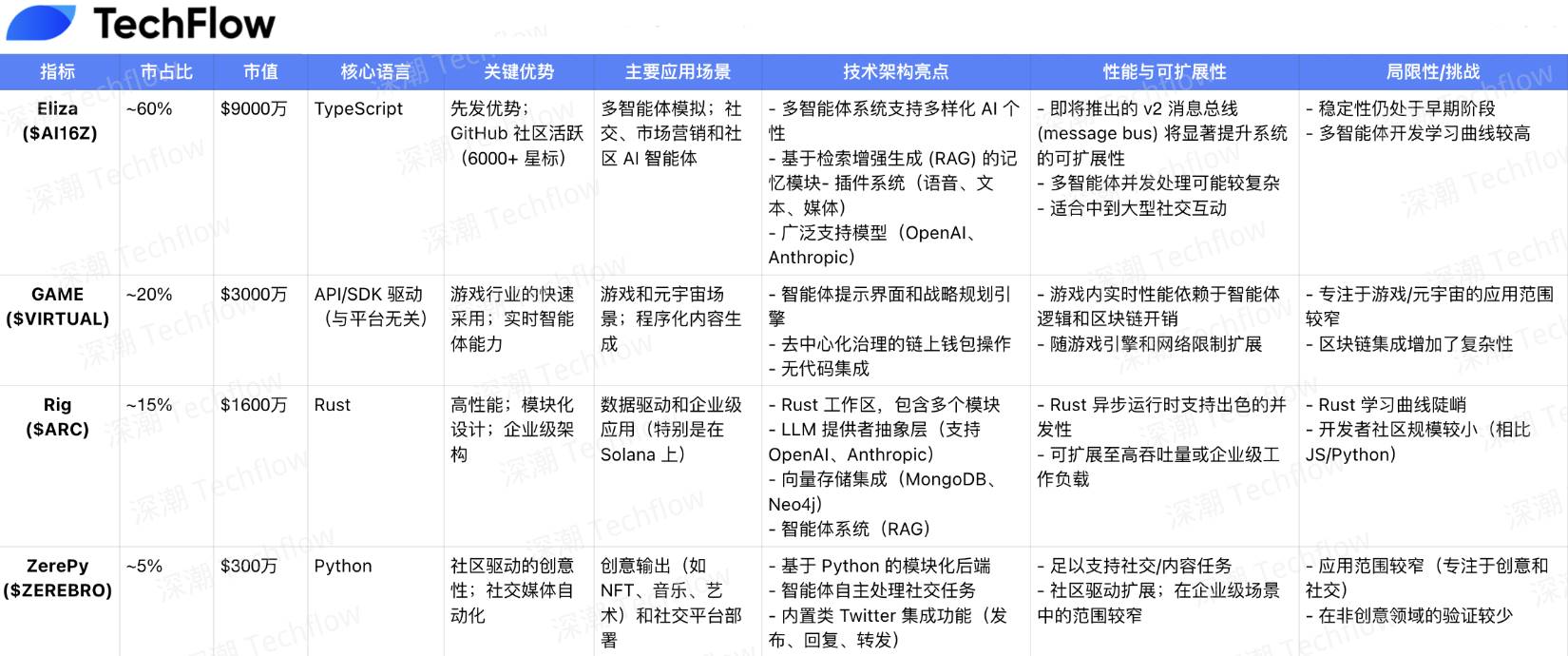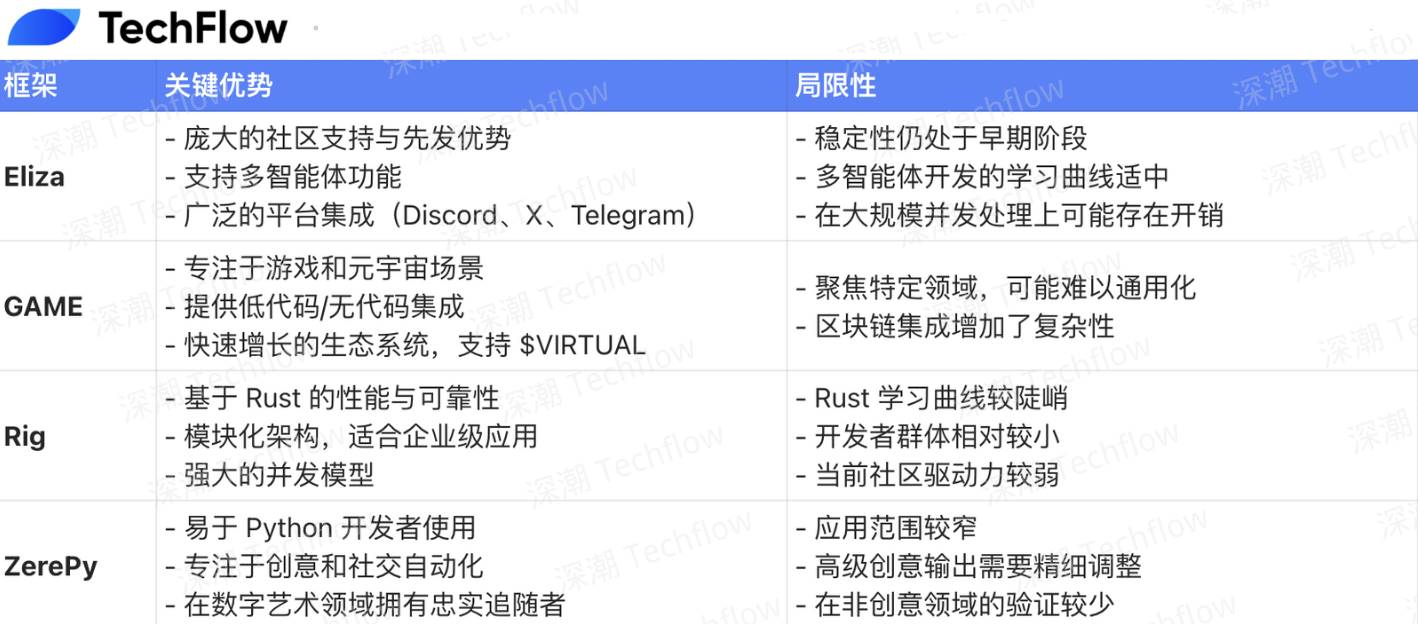Each framework occupies a unique market niche, and these frameworks are more complementary rather than directly competitive.
Author: arndxt
Translation: Deep Tide TechFlow
Introduction
Crypto x AI has gained significant attention, and Virtuals has surged (as of the time of this compilation, the market cap of Virtuals has exceeded $2.4 billion, with a 24-hour increase of up to 24%). Besides Virtuals, which other Crypto x AI frameworks are worth noting? What are the similarities and differences among these frameworks?
Deep Tide has compiled this article to analyze the technical architecture, market positioning, and potential impact of four major frameworks: Eliza ($AI16Z), GAME ($VIRTUAL), Rig ($ARC), and ZerePy ($ZEREBRO).
Main Text

In the Crypto x AI field, there are currently four major frameworks:
Eliza ($AI16Z)
GAME ($VIRTUAL)
Rig ($ARC)
ZerePy ($ZEREBRO)
These frameworks have clear positioning, aiming to meet the diverse needs of developers.
Eliza, with its first-mover advantage and active TypeScript community, occupies about 60% of the market share; GAME (~20%) focuses on gaming and metaverse applications and is rapidly gaining popularity.
Rig (~15%) is built on Rust, offering high-performance modular design, making it very suitable for the Solana ecosystem; while ZerePy (~5%) is an emerging framework based on Python, focusing on creative output and social media automation. Currently, the total valuation of these frameworks is $1.7 billion, and as AI-driven crypto applications continue to expand, the market size may exceed $20 billion, making market cap-weighted investment strategies a consideration. Each framework occupies a unique market niche—Eliza focuses on social and multi-agent interactions, GAME targets gaming and the metaverse, Rig is dedicated to enterprise-level performance, and ZerePy caters to creative community applications. These frameworks are more complementary rather than directly competitive.
1. Overview and Market Position

(The original English table is from @arndxt_xo, compiled by Deep Tide TechFlow)
1.1 Eliza ($AI16Z)
Market Share: ~60%
Market Cap: $90 million
Core Language: TypeScript
Main Advantages: First-mover advantage, large GitHub community (6,000+ stars, 1,800 forks)
Key Applications: Supports multi-agent simulations, cross-platform social interactions
As one of the earliest AI agent frameworks in the field, Eliza holds a dominant position. Its first-mover advantage is attributed to a large developer community, which not only accelerates the iteration of the framework's features but also drives widespread user adoption. The TypeScript-based tech stack makes it an ideal choice for developers engaged in web development, thus attracting a broad developer base.
1.2 GAME ($VIRTUAL)
Market Share: ~20%
Market Cap: $30 million
Core Language: Language-agnostic design based on API/SDK
Main Advantages: Rapid adoption in the gaming industry, supports real-time agent interactions
Key Applications: Procedural content generation, adaptive NPC behavior
GAME is designed specifically for gaming and metaverse applications. Its API-based architecture allows developers to easily integrate it into existing projects, while its close ties with the $VIRTUAL ecosystem have also driven rapid ecosystem development. As of now, over 200 projects have adopted this framework, with an average daily request volume of up to 150,000, and it continues to grow weekly. GAME's no-code integration feature is particularly valued, enabling teams looking to deploy projects quickly to launch functionalities without delving into technical details.
1.3 Rig ($ARC)
Market Share: ~15%
Market Cap: $16 million
Core Language: Rust
Main Advantages: High-performance modular design, optimized for the Solana ecosystem
Key Applications: Enterprise-level performance needs, complex transaction processing
Rig is a performance-focused framework built using Rust, fully leveraging Solana's high throughput advantages. Its modular design allows developers to flexibly customize features based on specific needs, making it very suitable for enterprise-level applications that require high performance and low latency. Although its market share is relatively small, its positioning within the Solana ecosystem makes it particularly attractive to developers involved in high-frequency trading and complex smart contract execution.
1.4 ZerePy ($ZEREBRO)
Market Share: ~5%
Market Cap: $30 million
Core Language: Python
Main Advantages: Focus on creative output and social media automation
Key Applications: Generative content, community interaction tools
As an emerging framework in the field, ZerePy uses Python as its core language, lowering the development threshold and attracting a large number of creative developers and content creators. Its focus on generative content and social media automation makes it an ideal choice for creative communities and marketing teams. Although its current market share is small, its growth potential cannot be overlooked.
2. Technical Architecture and Core Components
Eliza ($AI16Z)
Multi-Agent System: Supports multiple AI agents to collaborate or compete in the same runtime environment, suitable for complex interaction scenarios.
Memory Management (RAG): Enhances the contextual memory capability of generated content by retrieving relevant information, supporting long-term interactions.
Plugin System: Allows the community to develop extended functionalities, such as voice, text parsing, and multimedia file (e.g., PDF, images) processing.
Wide Model Support: Compatible with local open-source large language models (LLM) or cloud-based APIs (e.g., OpenAI, Anthropic).
Eliza's architecture is designed around multimodal communication, making it very suitable for social, marketing, and community-oriented AI applications. It supports easy integration into platforms like Discord, X (formerly Twitter), and Telegram, providing developers with rich extension options. However, effective management of multiple agents' personalities and memory modules is required during large-scale deployment to ensure system stability and efficiency.
GAME ($VIRTUAL)
API + SDK Model: Provides a streamlined agent integration solution for game studios and metaverse projects.
Agent Prompt Interface: Coordinates the interaction between user input and the agent's strategy engine, optimizing player experience.
Strategy Planning Engine: Divides agent logic into high-level goal planning and low-level strategy execution, enhancing the flexibility of character behavior.
Blockchain Integration: Supports on-chain wallet operations and decentralized agent governance, enhancing asset management capabilities within the metaverse.
GAME's architecture is optimized for gaming and metaverse scenarios, prioritizing real-time performance needs while supporting the dynamic adaptability of agents. Its strategy planning engine helps game characters set goals and adjust actions in real-time, providing players with a more immersive experience. Although its architecture can be extended to other fields, its design remains primarily focused on virtual worlds and procedurally generated application scenarios.
Rig ($ARC)
Rust Workspace Structure: Achieves clear and modular design by dividing functionalities into multiple independent packages.
Provider Abstraction Layer: Standardizes interactions with various LLM providers (e.g., OpenAI and Anthropic).
Vector Storage Integration: Supports multiple backends (MongoDB, Neo4j) to achieve contextual retrieval functionality.
Agent System: Integrates retrieval-augmented generation (RAG) and the use of dedicated tools.
Rig's high-performance architecture benefits from Rust's concurrency model, making it very suitable for enterprise applications that require strict resource management. Through a layered abstraction design philosophy, Rig offers high reliability, but Rust's steep learning curve may limit developer participation.
ZerePy ($ZEREBRO)
Python-Based: Designed for AI/ML developers familiar with Python libraries and development processes, easy to get started.
Modular Zerebro Backend: Provides generative content capabilities, particularly suitable for social media and the arts.
Agent Autonomy: Focuses on "creative output," including memes (internet pop culture content), music, and NFT generation tasks.
Social Platform Integration: Built-in features similar to Twitter, such as posting, replying, and retweeting operations.
ZerePy provides a solution for Python developers looking to quickly deploy agents on social platforms. Although its application scope is narrower than Eliza or Rig, ZerePy excels in artistic creation or entertainment-driven scenarios, especially in decentralized communities.
3. Comparison Dimensions
3.1 Usability
Eliza: Designed for balance, although the complexity of multi-agent systems brings a certain learning curve, the strong TypeScript developer community provides good support.
GAME: Specifically designed for non-technical users, especially in the gaming field, offering no-code or low-code development solutions that lower the entry barrier.
Rig: Requires a higher level of expertise from developers; the strictness of Rust necessitates certain professional skills, but its high performance and reliability offer substantial rewards for dedicated developers.
ZerePy: Very friendly to Python users, especially suitable for developers engaged in creative or media-related AI tasks.
3.2 Scalability
Eliza: The V2 version introduces an extensible message bus and optimized concurrency capabilities, but the task scheduling and resource allocation for multi-agents still require fine management.
GAME: Scalability depends on real-time gaming demands and the stability of the blockchain network; as long as the limitations of the game engine can be effectively controlled, performance remains excellent.
Rig: Naturally possesses high scalability due to Rust's asynchronous runtime, making it very suitable for high-throughput and enterprise-level workloads.
ZerePy: Scalability mainly relies on community-driven efforts, suitable for creative and social media fields, but support for large enterprise-level loads is relatively limited.
3.3 Adaptability
Eliza: The most adaptable, with a plugin system, extensive model support, and cross-platform integration capabilities, suitable for various application scenarios.
GAME: Highly adaptable in the gaming field, seamlessly integrating with various game engines, but its applicability in other areas is relatively weak.
Rig: Suitable for data-intensive or enterprise tasks, supporting flexible selection of various large language models and vector storage to meet complex scenario needs.
ZerePy: Focused on creative output, easily scalable relying on the Python ecosystem, but its application scope is relatively narrow.
3.4 Performance
Eliza: Optimized for social media and conversational tasks, its performance depends on the quality and response speed of external model APIs.
GAME: Provides excellent real-time performance in dynamic in-game contexts, with specific performance depending on the coordination between agent logic and blockchain overhead.
Rig: With Rust's concurrency capabilities and memory safety, it performs exceptionally well, especially suitable for complex large-scale AI processing tasks.
ZerePy: Performance mainly relies on Python's execution speed and model invocation efficiency, sufficient to support social and content creation tasks, but not suitable for enterprise-level high-throughput demands.
4. Advantages and Limitations

(The original English table is from @arndxt_xo, compiled by Deep Tide TechFlow)
5. Market Potential and Prospects
The total market cap of the four frameworks is currently $1.7 billion. If the AI and cryptocurrency (Crypto) fields can achieve explosive growth like L1 blockchains, their market potential may exceed $20 billion. For investors, market cap weighting may be a wiser strategy, especially as these frameworks serve different market areas and may benefit collectively from an overall market uptrend.
Eliza ($AI16Z): With a mature ecosystem, a strong codebase, and upcoming V2 features (such as the Coinbase agent toolkit and Trusted Execution Environment (TEE) support), it is expected to maintain its leading market share.
GAME ($VIRTUAL): The speed of adoption in the gaming and metaverse fields is accelerating, and the synergy with the $VIRTUAL ecosystem ensures continued developer attention.
Rig ($ARC): May become a "hidden gem" for enterprise AI on Solana. As the handshake program progresses, it is expected to replicate the successful model of other chain-specific frameworks.
ZerePy ($ZEREBRO): Although positioned more niche, it benefits from the support of the Python ecosystem and strong community momentum, focusing on creative and artistic fields that are often overlooked by more general solutions.
6. Comprehensive Comparative Insights
6.1 Tech Stack and Learning Curve
Eliza (TypeScript): Achieves a good balance between usability and feature richness.
GAME: Provides a simple and user-friendly API for game development, but its application scope is relatively limited.
Rig (Rust): Pursues extreme optimization for performance at the cost of higher complexity.
ZerePy (Python): Simple to operate in creative applications, but lacks broad applicability for enterprise-level needs.
6.2 Community and Ecosystem
Eliza: Has the largest community influence on GitHub, reflecting its wide applicability and strong community support.
GAME: Rapidly growing in the gaming and metaverse fields, benefiting from the support of the $VIRTUAL ecosystem.
Rig: Although the developer community is smaller, it is technically strong and focused on high-performance application scenarios.
ZerePy: Established a niche community around creativity and decentralized art, further enhancing its ecological influence through collaboration with Eliza.
6.3 Future Growth Catalysts
Eliza: The upcoming plugin registry and TEE integration may further solidify its market leadership.
GAME: Attracting more non-technical users through the expansion of the $VIRTUAL ecosystem, driving growth.
Rig: Potential Solana partnerships and enterprise-level positioning may bring significant growth as the developer community expands.
ZerePy: Leveraging Python's popularity in AI development and the trend of creative and community-driven projects, further solidifying its position in niche markets.
免责声明:本文章仅代表作者个人观点,不代表本平台的立场和观点。本文章仅供信息分享,不构成对任何人的任何投资建议。用户与作者之间的任何争议,与本平台无关。如网页中刊载的文章或图片涉及侵权,请提供相关的权利证明和身份证明发送邮件到support@aicoin.com,本平台相关工作人员将会进行核查。




